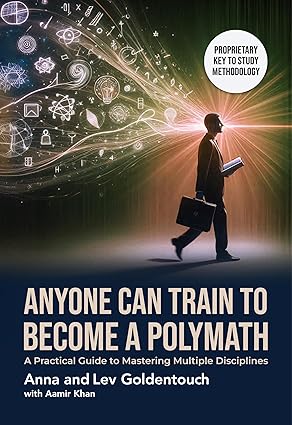The way we perceive ourselves plays a crucial role in shaping our identity, and this is especially true for polymaths—individuals with broad knowledge across various fields. Polymaths do not fit into one mold; they constantly evolve, explore new interests, and integrate multiple aspects of their personality into their identity. Instead of seeing ourselves through rigid labels, polymaths view their identity as fluid, shaped by continuous learning, self-discovery, and adaptation. The challenge lies in learning to shape that self-perception in ways that foster motivation, rather than allowing self-doubt or societal expectations to hold us back.
Rewriting Self-Perception: Identity as a Journey
A fundamental belief held by polymaths is that identity is not something we inherit, but something we actively construct. Many people limit themselves by identifying too strictly with a singular label—“I am a lawyer,” “I am not creative,” or “I struggle with math.” These labels confine individuals, preventing them from expanding their potential. On the other hand, polymaths embrace the idea that their identity is not fixed but constantly evolving based on the experiences they choose to engage with.
For example, if someone is interested in multiple fields, they may feel torn between them, unsure whether to specialize in one or embrace them all. This internal conflict, while challenging, is not a weakness but a source of strength. Polymaths use this tension to drive their creativity and innovation. The idea that contradictions within one’s interests are harmful is a misconception—rather, these contradictions are the fuel that allows polymaths to make unique connections between ideas and disciplines.
The Power of Internal Conflict
Polymaths often experience tension between diverse interests. For instance, Leonardo da Vinci is famous not only as an artist but also as an engineer and scientist. His anatomical studies informed his art, and his artistic vision guided his mechanical inventions. Similarly, Brian May, the lead guitarist of Queen, is not only known for his music but also holds a PhD in astrophysics. These examples show that rather than being pulled apart by multiple interests, polymaths allow their diverse passions to inform and elevate one another, creating a unique intersection of ideas.
Similarly, individuals who are interested in fields as varied as technology, philosophy, science, and the arts can use this internal conflict to explore new creative possibilities. Instead of suppressing multiple interests, polymaths embrace them as complementary assets. Each discipline offers a unique perspective, and by integrating them, polymaths can approach problems from angles that others may overlook.
Rewriting Your Narrative
How we frame our life experiences and struggles greatly influences our identity. Two people may face the same challenge, but their narratives can be vastly different. One person might view failure as a permanent setback, while another sees it as a valuable learning experience. The way we choose to interpret events shapes how we view ourselves and our potential.
A key example of this is Viktor Frankl, a Holocaust survivor and psychologist, who wrote Man’s Search for Meaning. Frankl argued that even in the most tragic circumstances, we have the power to assign meaning to our experiences. This concept applies to how we construct our identity. By reframing setbacks as learning experiences rather than failures, we can transform obstacles into stepping stones for growth.
For example, someone might think, “I have always struggled with public speaking.” Reframing this narrative to “I am actively improving my public speaking skills through practice and learning” shifts the focus from a fixed inability to a dynamic process of growth. This subtle shift in perspective can be a powerful tool in overcoming self-doubt and fostering long-term motivation.
Embracing Multiple Identities
One of the challenges polymaths face is the societal pressure to specialize. In many professions, specialization is prized over broad knowledge, and polymaths may feel pressured to narrow their focus. Yet, history shows that true innovation often happens at the intersection of disciplines.
Richard Feynman, a brilliant physicist, was also a talented artist and drummer. His ability to explain complex concepts in creative ways made him one of the most effective educators in his field. Similarly, Maya Angelou, a celebrated poet, was also a dancer, singer, civil rights activist, and professor. Her diverse experiences enriched her storytelling and activism. By embracing multiple identities, polymaths can harness a more holistic approach to problem-solving, creativity, and personal growth.
For many polymaths, it is not necessary to justify their wide-ranging interests. Instead, they embrace these multiple facets of their identity and view them as complementary rather than contradictory. Each interest or identity adds depth and richness to the whole, making the polymath uniquely capable of approaching challenges from diverse perspectives.
Legacy and Long-Term Motivation
While success in one’s career is important, polymaths are often driven by a desire to leave a lasting legacy. Instead of chasing transient accomplishments, they focus on making a meaningful impact on the world. The idea of legacy provides long-term motivation and guides their work, even in the face of setbacks or challenges.
Take Nikola Tesla, for example. Despite dying in poverty, Tesla’s contributions to electrical engineering changed the world. His work was not motivated by wealth or fame but by a desire to push the boundaries of human knowledge. This kind of long-term vision can serve as a powerful motivator for polymaths, helping them to stay focused on what truly matters and push through difficulties.
Polymaths can also draw motivation from thinking about the legacy they wish to leave behind. Reflecting on this larger purpose allows them to see beyond immediate rewards and helps shape their identity in a way that aligns with their deeper values and aspirations.
Identity Through Experimentation
Polymaths do not typically find their identity through a single defining moment. Rather, they discover their strengths through experimentation, trial, and error. Many of the most successful individuals in history did not follow a linear path to success but instead explored various fields before finding their calling.
Albert Einstein, for example, worked as a patent clerk before making his groundbreaking contributions to physics. Steve Jobs, meanwhile, had a background in calligraphy, which influenced the design aesthetics of Apple’s products. These individuals did not start with a clear vision of who they were meant to be; instead, they allowed their diverse interests and experiences to shape their identity over time.
Allowing room for experimentation is a crucial aspect of personal growth for polymaths. By trying new things, embracing failure, and continually rethinking their self-concept, polymaths are able to refine and reshape their identity in meaningful ways. This process of constant self-discovery enables them to stay adaptable and open to new possibilities, which is essential in both their personal and professional lives.
Overcoming Self-Doubt as a Polymath
Self-doubt is a natural companion of anyone with a diverse range of interests. Polymaths often question whether they are spreading themselves too thin or if they should focus on one path to achieve mastery. However, over time, they learn to view self-doubt as a sign of growth.
Rather than allowing self-doubt to derail their progress, polymaths embrace it as an indicator that they are challenging themselves and expanding their limits. The discomfort of uncertainty is often a sign that they are venturing into new territory and pushing the boundaries of their knowledge and abilities. Reframing self-doubt as a necessary part of the process enables polymaths to stay motivated and focused on their long-term goals.
By embracing self-doubt as a part of the journey, polymaths can overcome the fear of failure and continue to pursue their passions with confidence and resilience.
Embracing Polymath Identity
A polymath’s identity is not something static or fixed—it is a dynamic and evolving process. By embracing contradictions, reframing struggles as strengths, and focusing on long-term legacy, polymaths can create a personal narrative that empowers them. Their diverse interests are not burdens or distractions; they are integral to the unique perspectives that polymaths bring to the world. Instead of being constrained by society’s expectations, polymaths have the power to craft a narrative that celebrates their multifaceted identity and fuels their drive to contribute meaningfully to the world.
Polymaths can integrate diverse interests into a cohesive identity, which allows them to adapt, innovate, and thrive. By learning to view their multiple identities as complementary forces, polymaths can continue to grow and evolve, both personally and professionally.
Get Lost in the Story – Open This Book Now!
Suppose you want to learn more about shaping your identity as a polymath and how to embrace your diverse interests. In that case, “Anyone Can Train to Become a Polymath” by Dr. Lev Goldentouch and Prof. Anna Goldentouch provides a comprehensive guide. Whether you’re just starting your journey or looking to deepen your understanding of polymathy, this book offers insights and strategies to help you shape a powerful, multifaceted identity that can fuel lifelong growth and success.

